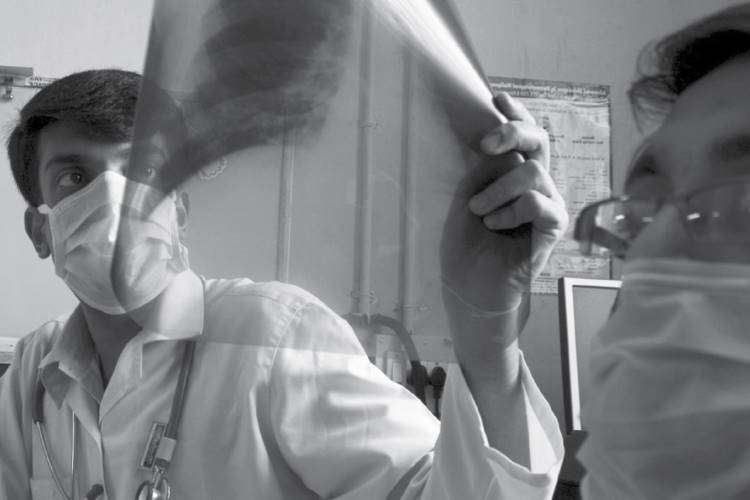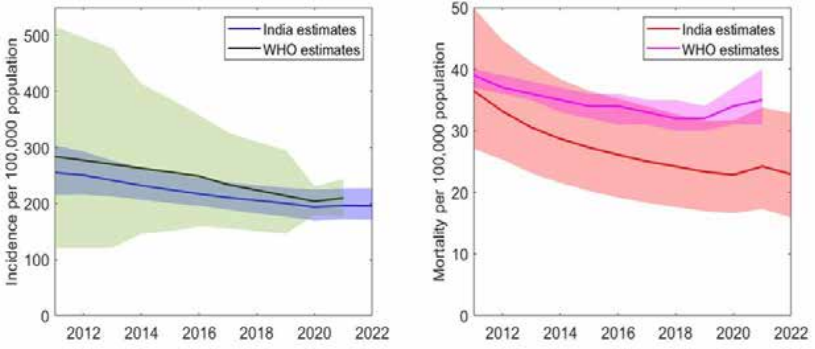
National TB elimination programme: With the 2025 deadline for eradicating tuberculosis rapidly approaching, India’s commitment and strategic approach are under scrutiny, especially considering the uneven progress across its states. The India TB Report 2023 presents a mixed picture, indicating both significant achievements and daunting challenges ahead.
The report reveals a worrying disparity among Indian states in terms of TB cure rates. While the national average cure rate is 27.8%, 11 states lag behind this benchmark, with the Bimaru states (Bihar, Madhya Pradesh, Rajasthan, and Uttar Pradesh) showing particularly low rates. This discrepancy not only underscores the geographical inequities within India, but also signals the need for a more focused and localised approach to TB elimination programme.
The economic impact of tuberculosis in India extend beyond the health sector, imposing a substantial burden on patients and the wider economy. TB patients often face loss of income due to prolonged illness, while their families bear the brunt of high treatment costs and associated care expenses. This economic strain is particularly acute in the poorer segments of society, where prevalence of TB is higher.
The disease not only depletes family resources but also contributes to poverty due to its ability to reduce workforce productivity. This aspect underlines the importance of addressing TB not just as a health issue but as a socio-economic challenge that requires comprehensive strategies encompassing financial support, poverty alleviation, and healthcare access improvements.
READ I Human Development Report 2023-24: India must address income disparities
National TB elimination programme
Despite these challenges, India has made noteworthy progress. The National TB Elimination Programme, spearheaded by the central TB division of the ministry of health and family welfare, has been instrumental in this. The increase in TB case notifications, especially through the private sector, signifies an enhanced detection rate which is crucial for effective TB control. Moreover, the expansion of diagnostic services across healthcare tiers and the provision of free laboratory services are pivotal steps towards improving access to TB care.
The COVID-19 pandemic has had a profound impact on TB detection and treatment in India, causing significant disruptions. Lockdowns and the diversion of healthcare resources to combat the pandemic led to a decrease in TB case notifications and hindered access to treatment services. The pandemic exacerbated challenges in the health system, leading to delayed diagnoses and interrupted treatment courses, which could potentially reverse the gains made in TB control over the years. Addressing these setbacks requires urgent attention to restore and enhance TB services, ensuring that the fight against TB remains a priority even in the aftermath of the pandemic.
Expansion of diagnostic technologies under NTEP

Different strokes: Mismatch between TB estimates

India’s battle against TB has been significantly bolstered by international collaboration and funding. Partnerships with global entities like the World Health Organisation (WHO) have provided critical support in terms of resources, expertise, and financial aid. These collaborations have helped to shape India’s TB control strategies, introducing global best practices and innovative approaches to detection, treatment, and prevention. Moreover, international funding has played a key role in scaling up TB programmes, especially in under-resourced and high-burden areas, facilitating access to quality care and advancing toward the elimination goals.
The prevalence of multidrug-resistant and rifampicin-resistant (MDR/RR) TB cases remains a significant hurdle. Effective management of these cases, along with the implementation of innovative strategies, is imperative to combat TB more effectively. The NTEP must focus on early detection, comprehensive treatment regimens, and ensuring patient adherence to mitigate the impact of these more complex TB cases.
The way ahead involves embracing innovation and improving programme efficiency. Digitalisation of TB care, from case notification to treatment monitoring, can streamline processes and enhance patient outcomes. Community engagement in TB awareness and prevention, alongside strengthening social support systems for patients, will be crucial in encouraging early diagnosis and sustaining treatment adherence. Additionally, ongoing research and development into new diagnostics, vaccines, and treatment modalities are essential for addressing the evolving challenges of TB management.
A shift towards patient-centred care and increased community involvement represents a significant evolution in India’s approach to the national TB elimination programme. Initiatives that focus on the needs and experiences of TB patients, such as community-based support programmes, help in improving treatment adherence and reducing stigma associated with the disease. Engaging local communities in TB awareness and prevention efforts ensures a broader reach and deeper impact of health interventions. Such strategies not only facilitate early detection and treatment but also empower patients and communities, fostering an inclusive and supportive environment for combating TB.
While India has made significant progress in curbing TB infections, the journey towards elimination is fraught with challenges. The disparities in cure rates across states, the burden of MDR/RR TB, and the need for innovative solutions underscore the complexity of TB elimination efforts. A multifaceted strategy that includes robust healthcare infrastructure, community involvement, and sustained research and development will be pivotal in achieving its goal of a TB-free nation by 2025. The road ahead is arduous, but with concerted efforts and strategic interventions, India can aspire to turn its vision of ending TB into a reality.
Advancements in research and innovation are crucial for overcoming the challenges posed by TB, especially with the rise of drug-resistant strains. New diagnostic tools, vaccines, and treatment regimens are being developed to improve the accuracy and speed of TB detection and to offer more effective and shorter treatment courses. These innovations are vital for managing and reducing the burden of TB, including the more complex forms like MDR/RR TB. Continued investment in research is essential to sustain progress and adapt to the evolving nature of the disease, ensuring that the tools and strategies used in national TB elimination programme are both effective and efficient.

